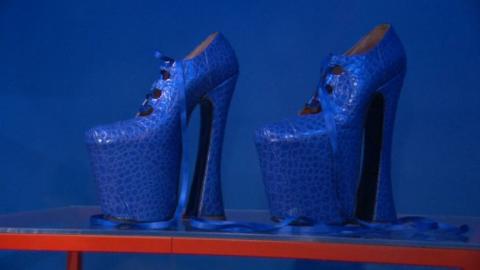New exhibition: Shoes: Pleasure and Pain
Shoes have often aimed more directly at seduction. No one knows the precise origins of the Chinese tradition for breaking the toe bones of young girls, bending them underneath the soles, and then binding the feet into the desired “three-inch-golden-lotus” shape. It was relatively common by the 11th century in all but the poorest women and the practice only died out in the 20th century. Bound feet restricted movement—they signalled that the woman had servants to do her walking for her—and were also considered highly erotic, both in themselves and because of the shuffling gait that women had to adopt. Oiran, high-class prostitutes in Japan, meanwhile, had to contend with heavy wooden clogs that could have platforms well over 20cm tall. Again this forced them to adopt a very slow, ritualised walk that showed off their clothes and, presumably, stamina. Fetishised footwear in the West include a pair of beautiful scarlet boots from Sweden, made at the beginning of the 20th century, and numerous pairs of mule heels. Their allure is neatly illustrated by a small reproduction of Fragonard’s “The Swing” (c. 1767)—this was a shoe only too ready to slip off its owner's feet, its looseness presumably echoing that of its owner’s morals.
Because shoes come into contact with the ground, they are a brilliant way of showing off wealth. Who but someone with money to spare and no need to do anything for themselves would wear highly decorative, uncomfortable, laughably impractical footwear? There is plenty of that here, and you can but wonder at humanity's ingenuity when it comes to dressing from the knee down. Men, it seems, are just inventive as women. One cabinet holds a pair of early-modern European gentleman’s boots with fold-overs so large they force the wearer to walk bow-legged. Poulaines, long narrow shoes with toes curled up like the tips of Salvador Dali’s moustache, were popular in the 14th century. More wonderful still are the intricately embroidered interiors of a pair of otherwise very plain pair of leather slippers from 19th-century Turkey: the decoration would only have been revealed as the owner walked away. “Shoes: Pleasure and Pain” is a quirky little gem of an exhibition: who knew our soles had so much to say?
Shoes: Pleasure and Pain is at the V&A in London until January 16th 2016.

